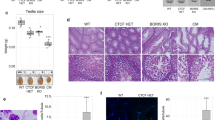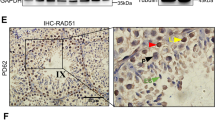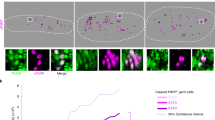Abstract
To identify genes required for mammalian spermatogenesis, we screened lines of mutant mice created using a retroviral genetrap system1 for male infertility. Homozygous ROSA41 male mice exhibit sterility associated with progressive testicular degeneration. Germ-cell defects are first observed at 19 days post-natal (p19). Spermatogenesis is blocked during late spermiogenesis in young adults. Gradual depletion of all stages of germ cells results in a Sertoli-cell-only phenotype by approximately six months of age. Subsequently, almost all Sertoli cells are lost from the seminiferous tubules and the Leydig cell population is reduced. Molecular analysis indicates that the gene mutated is Bclw, a death-protecting member of the Bcl2 family. The mutant allele of Bclw in ROSA41 does not produce a Bclw polypeptide. Expression of Bclw in the testis appears to be restricted to elongating spermatids and Sertoli cells. Potential roles for Bclw in testicular function are discussed.
This is a preview of subscription content, access via your institution
Access options
Subscribe to this journal
Receive 12 print issues and online access
$209.00 per year
only $17.42 per issue
Buy this article
- Purchase on Springer Link
- Instant access to full article PDF
Prices may be subject to local taxes which are calculated during checkout
Similar content being viewed by others
References
Friedrich, G. & Soriano, P. Promoter traps in embryonic stem cells: a genetic screen to identify and mutate developmental genes in mice. Genes Dev. 5, 1513–1523 (1991).
Gibson, L. et al. bcl-w, a novel member of the bcl-2 family, promotes cell survival. Oncogene 13, 665–675 (1996).
Townley, D.J., Avery, B.J., Rosen, B. & Skarnes, W.C. Rapid sequence analysis of gene trap integrations to generate a resource of insertional mutations in mice. Genome Res. 7, 293–298 (1997).
Enders, G.C. & May, J.J. Developmentally regulated expression of a mouse germ cell nuclear antigen examined from embryonic day 11 to adult in male and female. Dev. Biol. 163, 331–340 (1994).
Hall, P.A. et al. Proliferating cell nuclear antigen (PCNA) immunolocalization in paraffin sections : an index of cell proliferation with evidence of deregulated expression in some neoplasms. J. Pathol. 162, 285–294 (1990).
Russell, L.D. & Griswold, M.D. The Sertoli Cell. (Cache River Press, Clearwater, Florida, 1993).
Mori, C. et al. Morphological analysis of germ cell apoptosis during postnatal testis development in normal and Hsp 70-2 knockout mice. Dev. Dynamic. 208, 125–136 (1997).
Huckins, C. The morphology and kinetics of spermatogonial degeneration in normal adult rats : An analysis using a simplified classification of germinal epithelium. Anat Rec. 190, 905–926 (1978).
Korsmeyer, S.J. Regulators of cell death. Trends Genet. 11, 101–105 (1995).
Furuchi, T., Masuko, K., Nishimune, Y., Obinata, M. & Matsui, Y. Inhibition of testicular germ cell apoptosis and differentiation in mice misexpressing Bcl-2 in spermatogonia. Development 122, 1703–1709 (1996).
Knudson, C.M., Tung, K.S., Tourtellotte, W.G., Brown, G.A. & Korsmeyer, S.J. Bax-deficient mice with lymphoid hyperplasia and male germ cell death. Science 270, 96–99 (1995).
Vergouwen, R.P.F.A., Jacobs, S.G.P.M., Huiskamp, R., Davids, J.A.G. & de Rooij, D.G. Proliferative activity of gonocytes, Sertoli cells and interstitial cells during testicular development in mice. J. Reprod. Pert. 93, 233–243 (1991).
Farrow, S.N. et al. Cloning of a bcl-2 homologue by interaction with adenovirus E1B 19K. Nature 374, 731–733 (1995).
Skinner, M.K. in The Sertoli cell. (eds Russell, L.D. & Griswold, M.D.) 237–247 (Cache River Press, Clearwater, Florida, 1993).
Xia, Z., Dickens, M., Raingeaud, J., Davis, R.J. & Greenberg, M.E. Opposing effects of ERK and JNK-p38 MAP kinases on apoptosis. Science 270, 1326–1331 (1995).
Dudek, H. et al. Regulation of neuronal survival by the serine-threonine protein kinase Akt. Science 275, 661–665 (1997).
Cailleau, J., Vermeire, S. & Verhoeven, G. Independent control of the production of insulin-like growth factor I and its binding protein by cultured testicular cells. Mol. Cell. Endocrinol. 69, 79–89 (1990).
Ayer-LeLiviere, C., Olson, L., Ebendal, T., Hallbrook, F. & Persson, H. Nerve growth factor mRNA and protein in the testis and epididymis of mouse and rat. Proc. Natl. Acad. Sci. USA 85, 2628–2632 (1988).
Dirami, G., Ravindranath, N., Kleinman, H.K. & Dym, M. Evidence that basement membrane prevents apoptosis of Sertoli cells in vitro in the absence of known regulators of Sertoli cell function. Endocrinology 136, 4439–4447 (1995).
Sharpe, R.M. in The Sertoli cell (eds Russell, L.D. & Skinner, M.K.) 391–418 (Cache River Press, Clearwater, Florida, 1993).
MacGregor, G.R. & Caskey, C.T. Construction of plasmids that express E. coli beta-galactosidase in mammalian cells. Nucleic Acids Res. 17, 2365 (1989).
Ausubel, F.M. et al. Current Protocols in Molecular Biology. (Wiley Interscience, New York, 1994).
Rowe, L.B. et al. Maps from two interspecific backcross DNA panels available as a community genetic mapping resource. Mamm. Genome 5, 253–274 (1994).
Chaudhary, J., Cupp, A.S. & Skinner, M.K. Role of basic-helix-loop-helix transcription factors in Sertoli cell differentiation: identification of an E-box response element in the transferrin promoter. Endocrinology 138, 667–675 (1997).
MacGregor, G.R., Zambrowicz, B.P. & Soriano, P. Tissue non-specific alkaline phosphatase is expressed in both embryonic and extra-embryonic lineages during mouse embryogenesis but is not required for migration of primordial germ cells. Development 121, 1487–1496 (1995).
Sprando, R.L. in Histopathological Evaluation of the Testis. (eds Russell, L.D., Ettlin, R.A., Sinha Hikim, A.P. & Clegg, E.D.) 277–280 (Cache River Press, Clearwater, Florida, 1990).
Russell, L.D. & Burguet, S. Ultrastructure of Leydig cells as revealed by secondary treatment with a ferrocyanide-osmium mixture. Tissue Cell. 9, 751–766 (1977).
Author information
Authors and Affiliations
Corresponding author
Rights and permissions
About this article
Cite this article
Ross, A., Waymire, K., Moss, J. et al. Testicular degeneration in Bclw-deficient mice. Nat Genet 18, 251–256 (1998). https://doi.org/10.1038/ng0398-251
Received:
Accepted:
Issue Date:
DOI: https://doi.org/10.1038/ng0398-251



